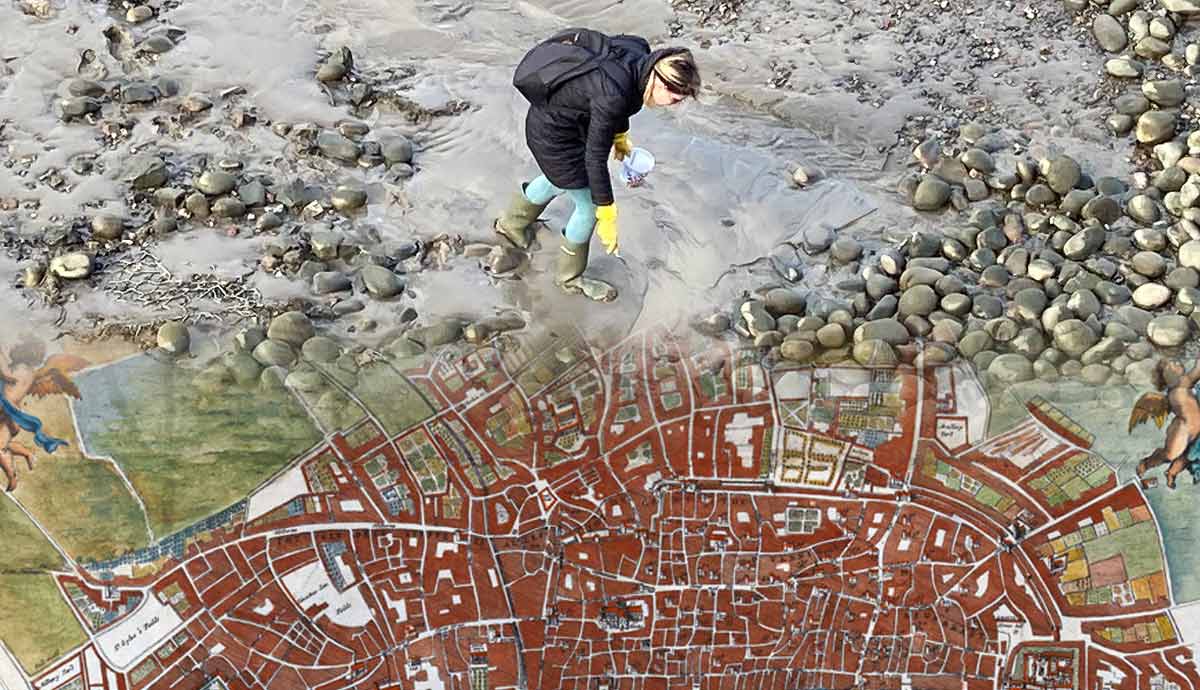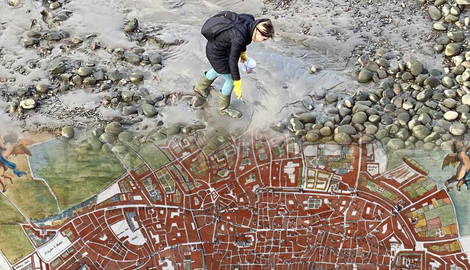
Wandering the embankments above the River Thames it is not unusual to see people down on the foreshore at low tide. Kneeling or hunched over, with eyes scanning the gravel and mud, they are mudlarking — hunting for little treasures. With the help of museums, the finds they make are shaping our understanding of London’s past. In this article, we will explore the world of mudlarking, look into the hobby’s grimy origins, and talk about some of the many pieces that can be found on the muddy banks of the famous river.
One Giant Archaeological Dig

With centuries of riverborne activity and human habitation along its banks, the Thames foreshore is one giant archeological dig. This is especially true along the frontage of the City of London, Southwark, Wapping, Rotherhithe, Deptford, and Greenwich, which was a maritime center for hundreds of years.
Discoveries can be made as far east as the Thames Estuary, up to 40 miles from central London, although mudlarks tend to use their own boats in this broad island-strewn reach of the river.
The mighty churn of the Thames, with its powerful currents and massive tidal range, dredges and deposits material on the foreshore. When the opaque brown water retreats, beachcombers step down to hunt for things that have been mislaid or discarded over the course of London’s long history. Objects survive in near-perfect condition, partly because oxygen cannot permeate the Thames’s mud.
Many mudlarks uncover something interesting on their first try. Each year, hundreds of finds with real cultural or material value qualify as treasure. But more often the worth of a find comes from the story that springs from it, and the picture it can help build about London’s past.
Long before mudlarking became a hobby, a lot of exciting things had been hauled from the bed of the Thames. During bridge construction in the mid-19th century, workers came across the Battersea Shield. On show at the British Museum, it is considered one of the finest pieces of Celtic art discovered in the UK.
The History of Mudlarking

One glance at the thick gloop that coalesces in patches along the banks, and it is easy to see why these collectors are commonly known as mudlarks and not beachcombers. All through the Victorian Era, mudlarks eked out a desperate living hunting for scrap.
It was often children who scavenged the banks. This was dangerous and highly unpleasant work, picking through sewage among the corpses of animals and sometimes humans for a pittance.
By the early 20th century, the mudlarking trade, in its traditional sense, had ended. Later that century the name was readopted by hobbyists, some swinging metal-detectors but many simply using their own eyes. Indeed, over time, mudlarks develop an astonishing ability to spot long-lost trinkets in the collage of pebbles, gravel, and mud.
What Treasures Can Be Found on the Banks of the Thames?

The variety of pieces waiting to be discovered is vast. Just to summarize, they might include Tudor earrings, or buttons of all shapes, sizes, and periods. People find thimbles, Roman hairpins, shards of 17th-century German glazed stoneware, keys, padlocks, coins, clay pipes, guns, and shell casings. Also hiding in the mud are medals, trade tokens, Medieval belt mounts, engraved lockets, 18th-century gin bottles, and clustered links of 15th-century chainmail armor.
Poison bottles, manufactured to hold hazardous chemicals like arsenic, show up often, usually in fragments, but sometimes whole. Dating from the 17th to the early 20th century, these were made in a standard hexagonal shape out of blue or green glass. This makes them easy to distinguish by those fortunate enough to find one.
Iron nails are ubiquitous. Most of these once held boats and ships together, and date from the 17th and 18th centuries. There are subtle clues that help people distinguish the exact time they were forged.
A big help is that the mass-production of nails, an American innovation, began at the turn of the 19th century. These streamlined nails differ from handmade nails, which have larger, pyramidical shanks with four distinct panels created by a blacksmith’s hammer. It can be humbling to pick up something as simple as a nail and inspect a professional’s handiwork 300 years later.
A Couple of Captivating Recent Finds

Every few months a news story surfaces about an interesting discovery made by a mudlark. In 2018, one Alan Suttie was taking a few minutes to browse the foreshore by Old Billingsgate Market while passing time before a meeting in the City. It was only the second time he had ever stepped onto the foreshore.
His eye was caught by something that had just been washed ashore by a wave and had lodged in the mud. What he found was an intact Roman-era oil lamp. It was crafted from terracotta in Carthage in the 4th or 5th century CE, and after appraisal was declared a “significant artifact” and claimed by the Museum of London.
The river’s highly preservative mud yields a lot of extremely delicate pieces that might otherwise not survive. For example, in 2021 another mudlark came across something utterly unique. Perusing the shore, her gaze was met by a human skull in miniature. This had been carved into a spherical piece of bone, and on the reverse side was a woman’s face, most likely representing the Virgin Mary. It was a single rosary bead, dating from around the mid-15th century, with the skull serving as a memento mori.
The Present and Future of Mudlarking

This niche hobby went mainstream in the early 21st century. In 2016, the Port of London Authority (PLA) introduced a permit scheme for mudlarking to keep things under control. Then, spurred by social media accounts and a need for outdoor hobbies during the Covid-19 pandemic, the 2020s brought on a “Wild West” of mudlarking.
Something easy to forget is that every stretch of the foreshore has an owner, requiring permission for access, as well as the right to pore over the beach. One of the largest landowners is the Crown Estate, which jointly runs the license scheme with the PLA.
At the time of writing, the PLA had put a temporary pause on applications for new foreshore permits. This is to preserve the historical integrity of the Thames foreshore. On the upside, the explosion in beachcombing hobbyists has helped historians understand London’s past better. Mudlarks are diligent when it comes to reporting finds that are deemed to be important, or are at least 300 years old, to the Portable Antiquities Scheme (PAS), administered by the British Museum.
Since the turn of the 2020s, annual records for reported treasures have tumbled year on year. The most recent figures at the time of writing were for 2022, in which some 53,500 finds were recorded across the United Kingdom. Of which almost 1,400 were legally defined as treasure.
Since 1998, the PAS has built an ever-growing, publicly accessible database of objects, with 1,715,745 items registered at the time of writing.
A Few Mudlarking Musts

The River Thames has an astonishing tidal range of more than 25 feet. Like the rest of the UK, London usually has two high tides and two low tides each day. This means that in a couple of hours a wide open beach will not just be submerged, but lost under multiple feet of roiling, murky water. So while the foreshore is engrossing, it is important to be aware of exit points.
A mudlark’s typical inventory will include a trowel, wellington boots (rubber boots), and gardening knee pads to make it easier to spot a Roman coin in the gravel. Many do not bring full-size metal detectors, which can be impractical, but may pack a handheld pinpointer. However, magnet fishing is not permitted on any part of the Thames foreshore.
Finally, while it has never been entirely safe to poke around the River Thames, microbiological dangers lurk in the 2020s. The quality of the water has declined sharply in recent years, and there are a few factors to blame. Lack of investment in the infrastructure is a big one, another is the sharp increase in groundwater caused by a series of record-breaking wet winters. Also key is that London’s population has increased from seven million in 2000 to nine million in 2024. The result is more sewage, which overflows more often when the groundwater level is high.
E. coli is a threat, as is the highly dangerous Weil’s disease, which is contracted from the urine of infected rats. Mudlarks are encouraged to wear gloves, keep cuts covered, and always refrain from touching their face when they’re on the foreshore.
How Can I Get Involved in Mudlarking?

We have seen that there is a hiatus on new permits, and new regulations from the Port of London Authority are in the pipeline. So for now, the best way to get a feel for mudlarking and the history on the Thames foreshore is through the Museum of London Archaeology. They run a variety of programs, including guided walks on the foreshore, community digs, exhibitions and conferences.








